The Spatiotemporal Evolution of the Mudflat Wetland in the Yellow Sea Using Landsat Time Series
Abstract
:1. Introduction
2. Materials and Methods
2.1. Study Area
2.2. Data Source and Data Pre-Processing
2.3. Extraction Method of Mudflat Wetland
2.4. Classification Accuracy of Mudflat Wetland
2.5. The Construction of the Method of Intertidal Zone Extraction
3. Results
3.1. Changes in the Mudflat Wetland
3.1.1. Spatial Changes
3.1.2. Temporal Changes
3.2. Land Use Change Trajectories from 1983 to 2020
3.3. Results and Validation of Intertidal Zone Extraction
4. Discussion
4.1. Object-Oriented and Decision Tree Classification and the IWI
4.2. Impact of Ocean Dynamics
4.3. The Impact of Artificial Consolidation of the Shoreline
4.4. Impact of Socio-Economic Development and Policies
5. Conclusions
- (1)
- Object-oriented and decision tree classification and the IWI are highly effective methods for extracting the mudflat wetland and muddy intertidal zone. The mudflat wetland area in the Yellow Sea decreased from 8940.20 km2 in 1983 to 7658.14 km2 by 2020, with a reduction rate of 337.38 km2/10a. The area of the natural mudflat wetland decreased by 446.94 km2/10a, while the human-made wetland increased by 109.56 km2/10a. Additionally, the area of the intertidal zone, which covered 3058.18 km2 in 1983, experienced a decline of 429.02 km2/10a.
- (2)
- Affected by factors like the economy, policy, ocean dynamics, and species invasion, the area of the natural mudflat wetland and intertidal zone in the Yellow Sea had been shrinking at a similar rate. Both of them had a decrease of about 45 km2/a, with significant changes occurring between 2000 and 2010. The main loss type of the natural wetland was tidal flats, followed by marsh. Conversely, the human-made wetland was increasing, driven by factors such as reclamation.
- (3)
- At present, the policies related to wetland protection have achieved some positive outcomes. It is suggested that wetland protection work should be further deepened from the following aspects: further improving the laws and regulations of wetland protection and the protection system of wetland reserves; establishing extensive wetland ecological monitoring sites to detect changes in the wetland ecosystem over time; and strengthening publicity and education to build public awareness of wetland protection.
Author Contributions
Funding
Data Availability Statement
Acknowledgments
Conflicts of Interest
References
- Boak, E.H.; Turner, I.L. Shoreline definition and detection: A review. J. Coast. Res. 2005, 21, 688–703. [Google Scholar] [CrossRef]
- Mujabar, P.S.; Chandrasekar, N. Shoreline change analysis along the coast between Kanyakumari and Tuticorin of India using remote sensing and GIS. Arab. J. Geosci. 2013, 6, 647–664. [Google Scholar] [CrossRef]
- Wang, Z.; Wu, J.; Madden, M.; Mao, D. China’s wetlands: Conservation plans and policy impacts. Ambio 2012, 41, 782–786. [Google Scholar] [CrossRef] [PubMed]
- Ramachandran, A.; Enserink, B.; Balchand, A. Coastal regulation zone rules in coastal panchayats (villages) of Kerala, India vis-à-vis socio-economic impacts from the recently introduced peoples’ participatory program for local self-governance and sustainable development. Ocean Coast. Manag. 2005, 48, 632–653. [Google Scholar] [CrossRef]
- Houghton, J.T.; Ding, Y.; Griggs, D.J.; Noguer, M.; van der Linden, P.J.; Dai, X.; Maskell, K.; Johnson, C.A. Climate Change 2001: The Scientific Basis; Cambridge University Press: Cambridge, UK, 2001; Volume 881. [Google Scholar]
- Asselen, S.v.; Verburg, P.H.; Vermaat, J.E.; Janse, J.H. Drivers of wetland conversion: A global meta-analysis. PLoS ONE 2013, 8, e81292. [Google Scholar] [CrossRef]
- Kirwan, M.L.; Megonigal, J.P. Tidal wetland stability in the face of human impacts and sea-level rise. Nature 2013, 504, 53–60. [Google Scholar] [CrossRef]
- Mao, D.; Wang, Z.; Wu, J.; Wu, B.; Zeng, Y.; Song, K.; Yi, K.; Luo, L. China’s wetlands loss to urban expansion. Land Degrad. Dev. 2018, 29, 2644–2657. [Google Scholar] [CrossRef]
- Niu, Z.; Gong, P.; Cheng, X.; Guo, J.; Wang, L.; Huang, H.; Shen, S.; Wu, Y.; Wang, X.; Wang, X. Geographical characteristics of China’s wetlands derived from remotely sensed data. Sci. China Ser. D Earth Sci. 2009, 52, 723–738. [Google Scholar] [CrossRef]
- National Forestry and Grassland Administration. The Report on the Second National Wetland Resources Survey (2009–2013). 2014. Available online: https://www.forestry.gov.cn/main/65/20140128/758154.html (accessed on 25 March 2023). (In Chinese)
- Nahlik, A.M.; Fennessy, M.S. Carbon storage in US wetlands. Nat. Commun. 2016, 7, 13835. [Google Scholar] [CrossRef]
- Zhu, P.; Gong, P. Suitability mapping of global wetland areas and validation with remotely sensed data. Sci. China Earth Sci. 2014, 57, 2283–2292. [Google Scholar] [CrossRef]
- Wang, W.; Sardans, J.; Wang, C.; Zeng, C.; Tong, C.; Chen, G.; Huang, J.; Pan, H.; Peguero, G.; Vallicrosa, H. The response of stocks of C, N, and P to plant invasion in the coastal wetlands of China. Glob. Change Biol. 2019, 25, 733–743. [Google Scholar] [CrossRef] [PubMed]
- Xia, S.; Song, Z.; Van Zwieten, L.; Guo, L.; Yu, C.; Wang, W.; Li, Q.; Hartley, I.P.; Yang, Y.; Liu, H. Storage, patterns and influencing factors for soil organic carbon in coastal wetlands of China. Glob. Change Biol. 2022, 28, 6065–6085. [Google Scholar] [CrossRef]
- Cui, B.; He, Q.; Gu, B.; Bai, J.; Liu, X. China’s coastal wetlands: Understanding environmental changes and human impacts for management and conservation. Wetlands 2016, 36, 1–9. [Google Scholar] [CrossRef]
- Murray, N.J.; Clemens, R.S.; Phinn, S.R.; Possingham, H.P.; Fuller, R.A. Tracking the rapid loss of tidal wetlands in the Yellow Sea. Front. Ecol. Environ. 2014, 12, 267–272. [Google Scholar] [CrossRef]
- Chen, S.-s.; Chen, L.-f.; Liu, Q.-h.; Li, X.; Tan, Q. Remote sensing and GIS-based integrated analysis of coastal changes and their environmental impacts in Lingding Bay, Pearl River Estuary, South China. Ocean Coast. Manag. 2005, 48, 65–83. [Google Scholar] [CrossRef]
- Sarma, P.K.; Lahkar, B.P.; Ghosh, S.; Rabha, A.; Das, J.P.; Nath, N.K.; Dey, S.; Brahma, N. Land-use and land-cover change and future implication analysis in Manas National Park, India using multi-temporal satellite data. Curr. Sci. 2008, 95, 223–227. [Google Scholar]
- Green, E.P.; Clark, C.; Mumby, P.; Edwards, A.; Ellis, A. Remote sensing techniques for mangrove mapping. Int. J. Remote Sens. 1998, 19, 935–956. [Google Scholar] [CrossRef]
- Seto, K.C.; Fragkias, M. Quantifying spatiotemporal patterns of urban land-use change in four cities of China with time series landscape metrics. Landsc. Ecol. 2005, 20, 871–888. [Google Scholar] [CrossRef]
- Kumar, P.D.; Gopinath, G.; Laluraj, C.; Seralathan, P.; Mitra, D. Change detection studies of Sagar Island, India, using Indian remote sensing satellite 1C linear imaging self-scan sensor III data. J. Coast. Res. 2007, 23, 1498–1502. [Google Scholar] [CrossRef]
- Barducci, A.; Guzzi, D.; Marcoionni, P.; Pippi, I. Aerospace wetland monitoring by hyperspectral imaging sensors: A case study in the coastal zone of San Rossore Natural Park. J. Environ. Manag. 2009, 90, 2278–2286. [Google Scholar] [CrossRef] [PubMed]
- Amani, M.; Brisco, B.; Afshar, M.; Mirmazloumi, S.M.; Mahdavi, S.; Mirzadeh, S.M.J.; Huang, W.; Granger, J. A generalized supervised classification scheme to produce provincial wetland inventory maps: An application of Google Earth Engine for big geo data processing. Big Earth Data 2019, 3, 378–394. [Google Scholar] [CrossRef]
- Mahdavi, S.; Salehi, B.; Granger, J.; Amani, M.; Brisco, B.; Huang, W. Remote sensing for wetland classification: A comprehensive review. GISci. Remote Sens. 2018, 55, 623–658. [Google Scholar] [CrossRef]
- Rezaee, M.; Mahdianpari, M.; Zhang, Y.; Salehi, B. Deep convolutional neural network for complex wetland classification using optical remote sensing imagery. IEEE J. Sel. Top. Appl. Earth Obs. Remote Sens. 2018, 11, 3030–3039. [Google Scholar] [CrossRef]
- Gallant, A.L. The challenges of remote monitoring of wetlands. Remote Sens. 2015, 7, 10938–10950. [Google Scholar] [CrossRef]
- Mui, A.; He, Y.; Weng, Q. An object-based approach to delineate wetlands across landscapes of varied disturbance with high spatial resolution satellite imagery. ISPRS J. Photogramm. Remote Sens. 2015, 109, 30–46. [Google Scholar] [CrossRef]
- Zhang, L.; Li, X.; Yuan, Q.; Liu, Y. Object-based approach to national land cover mapping using HJ satellite imagery. J. Appl. Remote Sens. 2014, 8, 083686. [Google Scholar] [CrossRef]
- Blaschke, T. Object based image analysis for remote sensing. ISPRS J. Photogramm. Remote Sens. 2010, 65, 2–16. [Google Scholar] [CrossRef]
- Dronova, I. Object-based image analysis in wetland research: A review. Remote Sens. 2015, 7, 6380–6413. [Google Scholar] [CrossRef]
- Campbell, A.; Wang, Y. Examining the influence of tidal stage on salt marsh mapping using high-spatial-resolution satellite remote sensing and topobathymetric LiDAR. IEEE Trans. Geosci. Remote Sens. 2018, 56, 5169–5176. [Google Scholar] [CrossRef]
- Dronova, I.; Gong, P.; Wang, L. Object-based analysis and change detection of major wetland cover types and their classification uncertainty during the low water period at Poyang Lake, China. Remote Sens. Environ. 2011, 115, 3220–3236. [Google Scholar] [CrossRef]
- Zhu, H.; Qin, P.; Wang, H. Functional group classification and target species selection for Yancheng Nature Reserve, China. Biodivers. Conserv. 2004, 13, 1335–1353. [Google Scholar] [CrossRef]
- Zhang, H.; Zhen, Y.; Li, Y.; Sun, X. Spatial heterogeneity of soil salinity in Jiangsu Yancheng Wetland National Nature Reserve rare birds. Wetl. Sci 2018, 16, 152–158. [Google Scholar]
- Ou, W.; Yang, G.; Li, H.-P.; Yu, X. Spatio-temporal variation and driving forces of landscape patterns in the coastal zone of Yancheng, Jiangsu. Sci. Geogr. Sin. 2004, 24, 610–615. [Google Scholar]
- Zuo, P.; Wan, S.W.; Qin, P.; Du, J.; Wang, H. A comparison of the sustainability of original and constructed wetlands in Yancheng Biosphere Reserve, China: Implications from emergy evaluation. Environ. Sci. Policy 2004, 7, 329–343. [Google Scholar] [CrossRef]
- Sun, Z.; Sun, W.; Tong, C.; Zeng, C.; Yu, X.; Mou, X. China’s coastal wetlands: Conservation history, implementation efforts, existing issues and strategies for future improvement. Environ. Int. 2015, 79, 25–41. [Google Scholar] [CrossRef]
- Niu, Z.; Zhang, H.; Gong, P. More protection for China’s wetlands. Nature 2011, 471, 305. [Google Scholar] [CrossRef]
- An, S.; Li, H.; Guan, B.; Zhou, C.; Wang, Z.; Deng, Z.; Zhi, Y.; Liu, Y.; Xu, C.; Fang, S. China’s natural wetlands: Past problems, current status, and future challenges. AMBI A J. Hum. Environ. 2007, 36, 335–342. [Google Scholar] [CrossRef]
- Gong, P.; Niu, Z.; Cheng, X.; Zhao, K.; Zhou, D.; Guo, J.; Liang, L.; Wang, X.; Li, D.; Huang, H. China’s wetland change (1990–2000) determined by remote sensing. Sci. China Earth Sci. 2010, 53, 1036–1042. [Google Scholar] [CrossRef]
- Mao, D.; Wang, Z.; Du, B.; Li, L.; Tian, Y.; Jia, M.; Zeng, Y.; Song, K.; Jiang, M.; Wang, Y. National wetland mapping in China: A new product resulting from object-based and hierarchical classification of Landsat 8 OLI images. ISPRS J. Photogramm. Remote Sens. 2020, 164, 11–25. [Google Scholar] [CrossRef]
- Ke, C.-Q.; Zhang, D.; Wang, F.-Q.; Chen, S.-X.; Schmullius, C.; Boerner, W.-M.; Wang, H. Analyzing coastal wetland change in the Yancheng national nature reserve, China. Reg. Environ. Change 2011, 11, 161–173. [Google Scholar] [CrossRef]
- Zang, Z.; Zou, X.; Zuo, P.; Song, Q.; Wang, C.; Wang, J. Impact of landscape patterns on ecological vulnerability and ecosystem service values: An empirical analysis of Yancheng Nature Reserve in China. Ecol. Indic. 2017, 72, 142–152. [Google Scholar] [CrossRef]
- Xu, C.; Pu, L.; Zhu, M.; Li, J.; Chen, X.; Wang, X.; Xie, X. Ecological security and ecosystem services in response to land use change in the coastal area of Jiangsu, China. Sustainability 2016, 8, 816. [Google Scholar] [CrossRef]
- Shen, F.; Gao, A.; Wu, J.; Zhou, Y.; Zhang, J. A remotely sensed approach on waterline extraction of silty tidal flat for DEM construction, a case study in Jiuduansha Shoal of Yangtze River. Acta Geod. Cartogr. Sin. 2008, 37, 102–107. [Google Scholar]
- Tang, W.; Zhao, C.; Lin, J.; Jiao, C.; Zheng, G.; Zhu, J.; Pan, X.; Han, X. Improved spectral water index combined with Otsu algorithm to extract muddy coastline data. Water 2022, 14, 855. [Google Scholar] [CrossRef]
- Murray, N.J.; Phinn, S.R.; DeWitt, M.; Ferrari, R.; Johnston, R.; Lyons, M.B.; Clinton, N.; Thau, D.; Fuller, R.A. The global distribution and trajectory of tidal flats. Nature 2019, 565, 222–225. [Google Scholar] [CrossRef]
- Ozesmi, S.L.; Bauer, M.E. Satellite remote sensing of wetlands. Wetl. Ecol. Manag. 2002, 10, 381–402. [Google Scholar] [CrossRef]
- Murray, N.J.; Phinn, S.R.; Clemens, R.S.; Roelfsema, C.M.; Fuller, R.A. Continental scale mapping of tidal flats across East Asia using the Landsat archive. Remote Sens. 2012, 4, 3417–3426. [Google Scholar] [CrossRef]
- Jia, M.; Wang, Z.; Mao, D.; Ren, C.; Wang, C.; Wang, Y. Rapid, robust, and automated mapping of tidal flats in China using time series Sentinel-2 images and Google Earth Engine. Remote Sens. Environ. 2021, 255, 112285. [Google Scholar] [CrossRef]
- Xu, N.; Wang, Y.; Huang, C.; Jiang, S.; Jia, M.; Ma, Y. Monitoring coastal reclamation changes across Jiangsu Province during 1984–2019 using landsat data. Mar. Policy 2022, 136, 104887. [Google Scholar] [CrossRef]
- Sun, W.; Huang, Y.; Huang, B. Study on Spatial-Temporal Characteristics of Jiangsu Coastline. Mod. Surv. Mapp. 2018, 41, 32–35. (In Chinese) [Google Scholar]
- Wang, X.; Yan, F.; Su, F. Changes in coastline and coastal reclamation in the three most developed areas of China, 1980–2018. Ocean Coast. Manag. 2021, 204, 105542. [Google Scholar] [CrossRef]
- Huang, L.; Zhao, C.; Jiao, C.; Zheng, G.; Zhu, J. Quantitative analysis of rapid siltation and erosion caused coastline evolution in the coastal mudflat areas of Jiangsu. Water 2023, 15, 1679. [Google Scholar] [CrossRef]
- Zhou, L.; Zhang, Z.; Lu, K. Shoreline Change and Reclamation of Silty Coast in Jiangsu Province during 1985–2002. Mar. Geol. Front 2010, 26, 7–11. [Google Scholar]
- Li, M.; Wu, S.; Gong, X.; Yang, L.; Gou, F.; Li, J. Characteristics of coastline change under the influence of human activities in central Jiangsu Province from 1989 to 2019. Mar. Sci 2022, 46, 60–68. [Google Scholar]
- Marrone, J.; Zhou, S.; Brashear, P.; Howe, B.; Baker, S. Numerical and Physical Modeling to Inform Design of the Living Breakwaters Project, Staten Island, New York. Coast. Struct. 2019, 2019, 1044–1054. [Google Scholar]
- Chen, W.; Zhang, D.; Cui, D.; Lv, L.; Xie, W.; Shi, S.; Hou, Z. Monitoring spatial and temporal changes in the continental coastline and the intertidal zone in Jiangsu province, China. Acta Geogr. Sin 2018, 73, 1365–1380. [Google Scholar]
- Tang, T.; Zhang, W. A discussion of ecological engineering benefits of Spartina spp. and its ecological invasion. Eng. Sci. 2003, 5, 15–20. [Google Scholar]
- Shuwen, W.; Pei, Q.; Yang, L.; Xi-Ping, L. Wetland creation for rare waterfowl conservation: A project designed according to the principles of ecological succession. Ecol. Eng. 2001, 18, 115–120. [Google Scholar] [CrossRef]
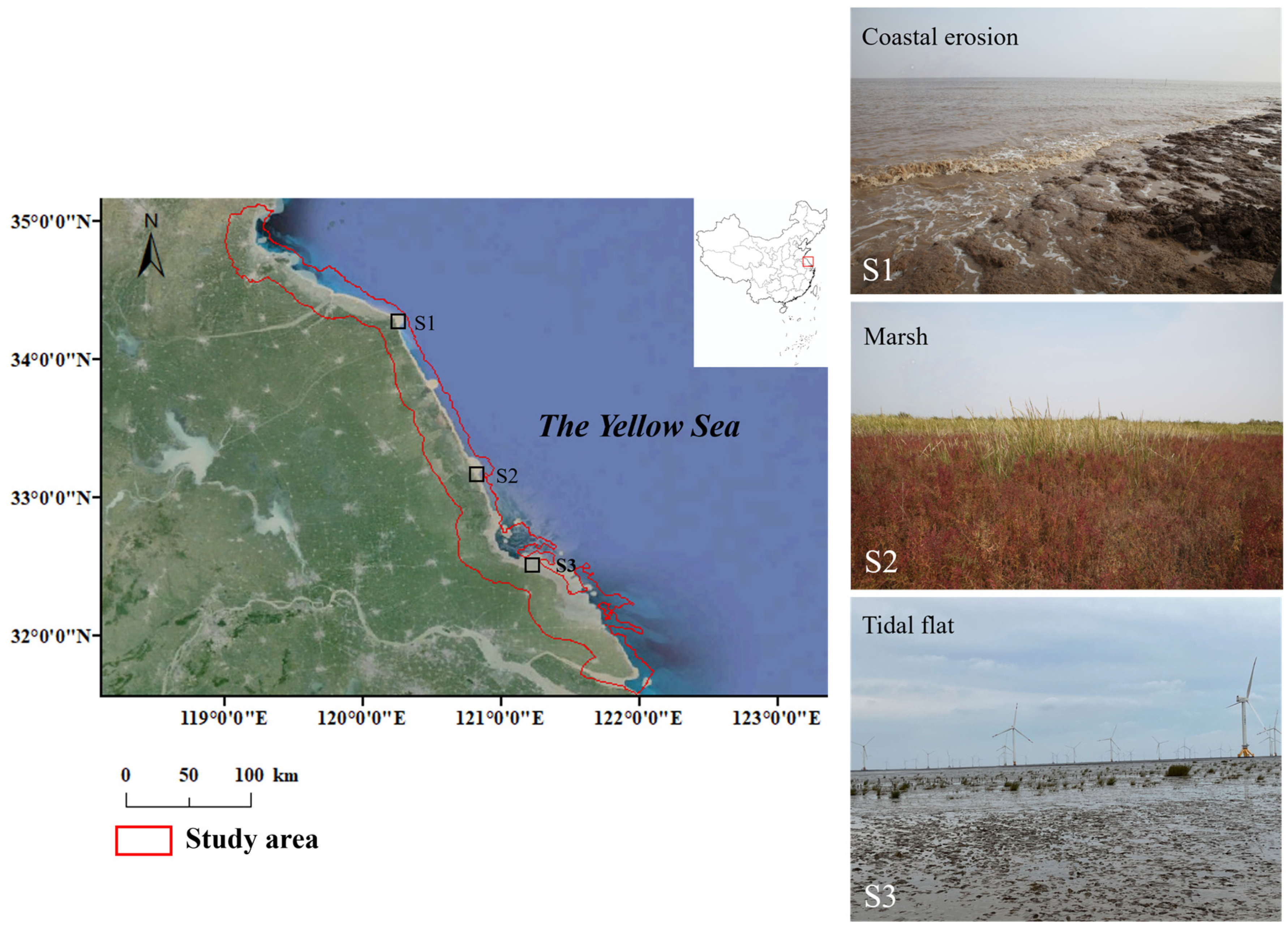
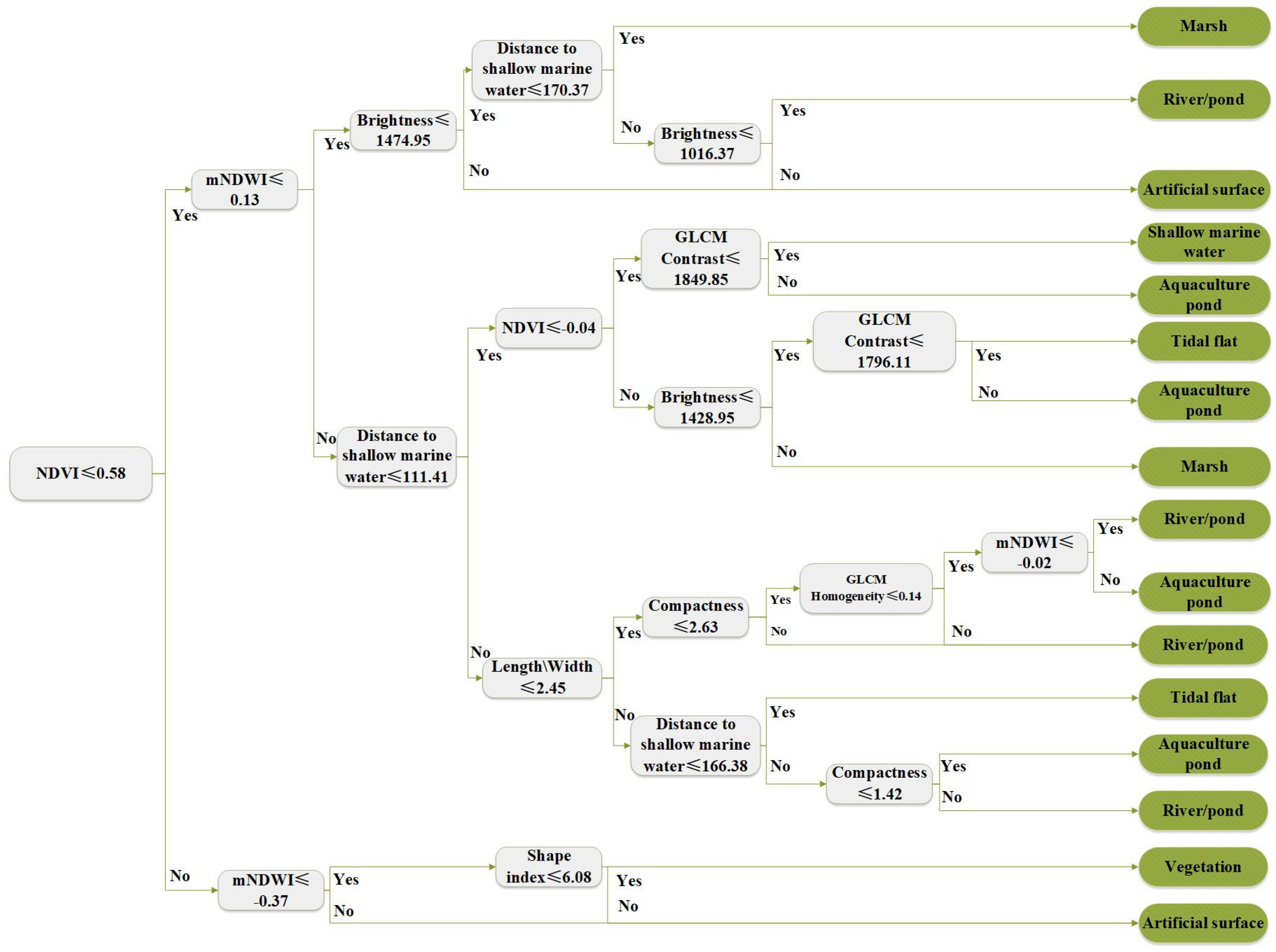
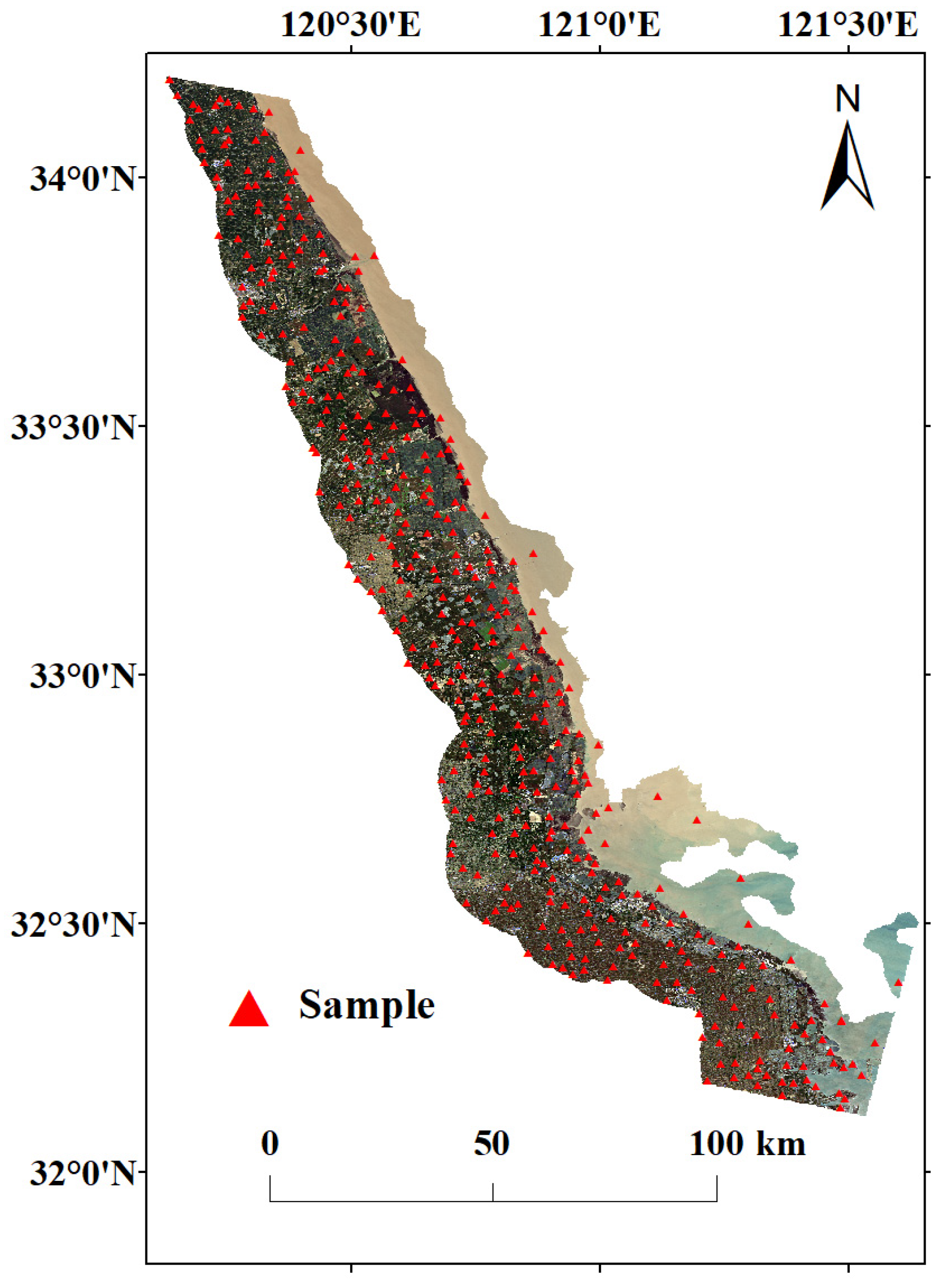
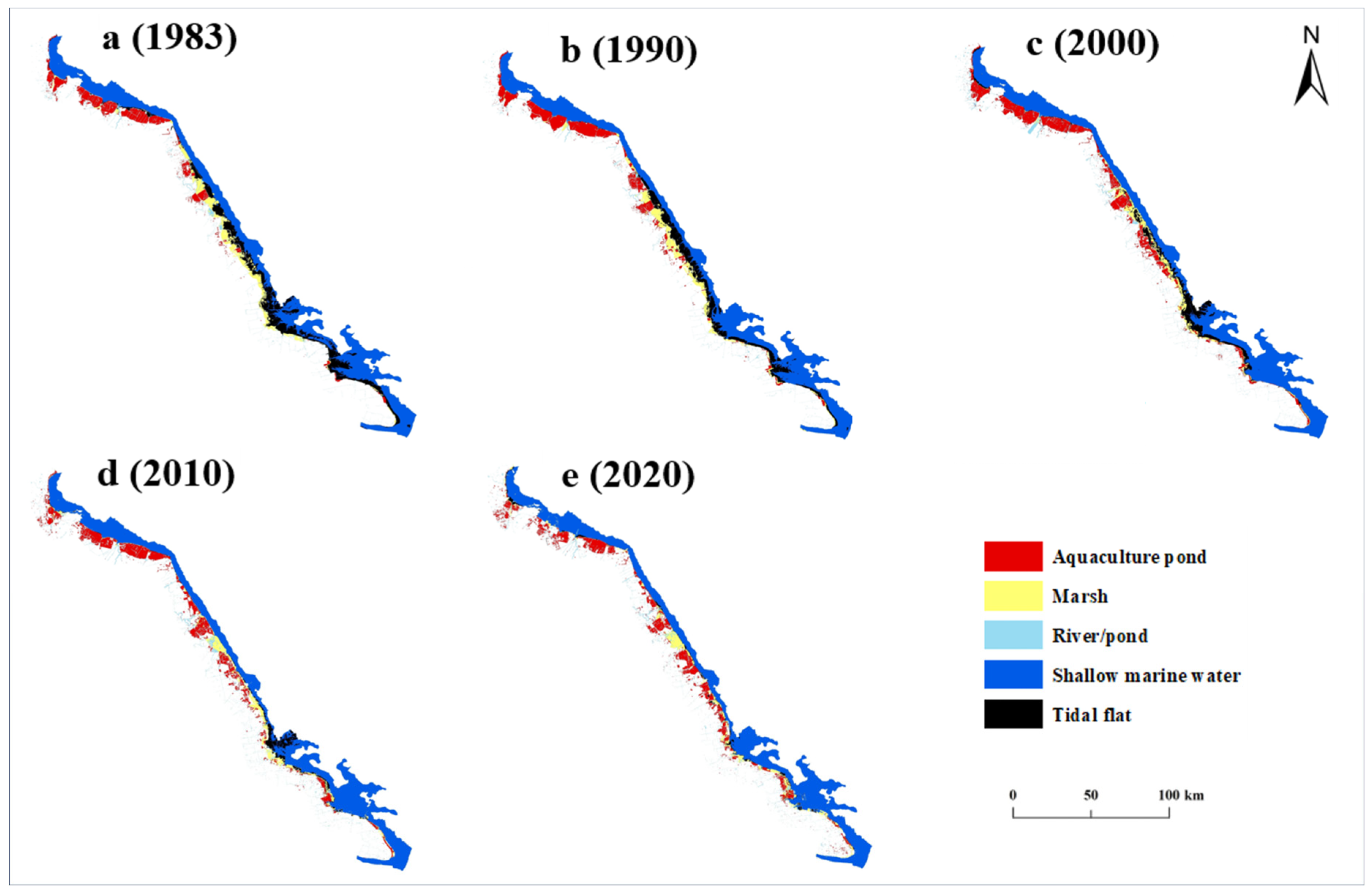

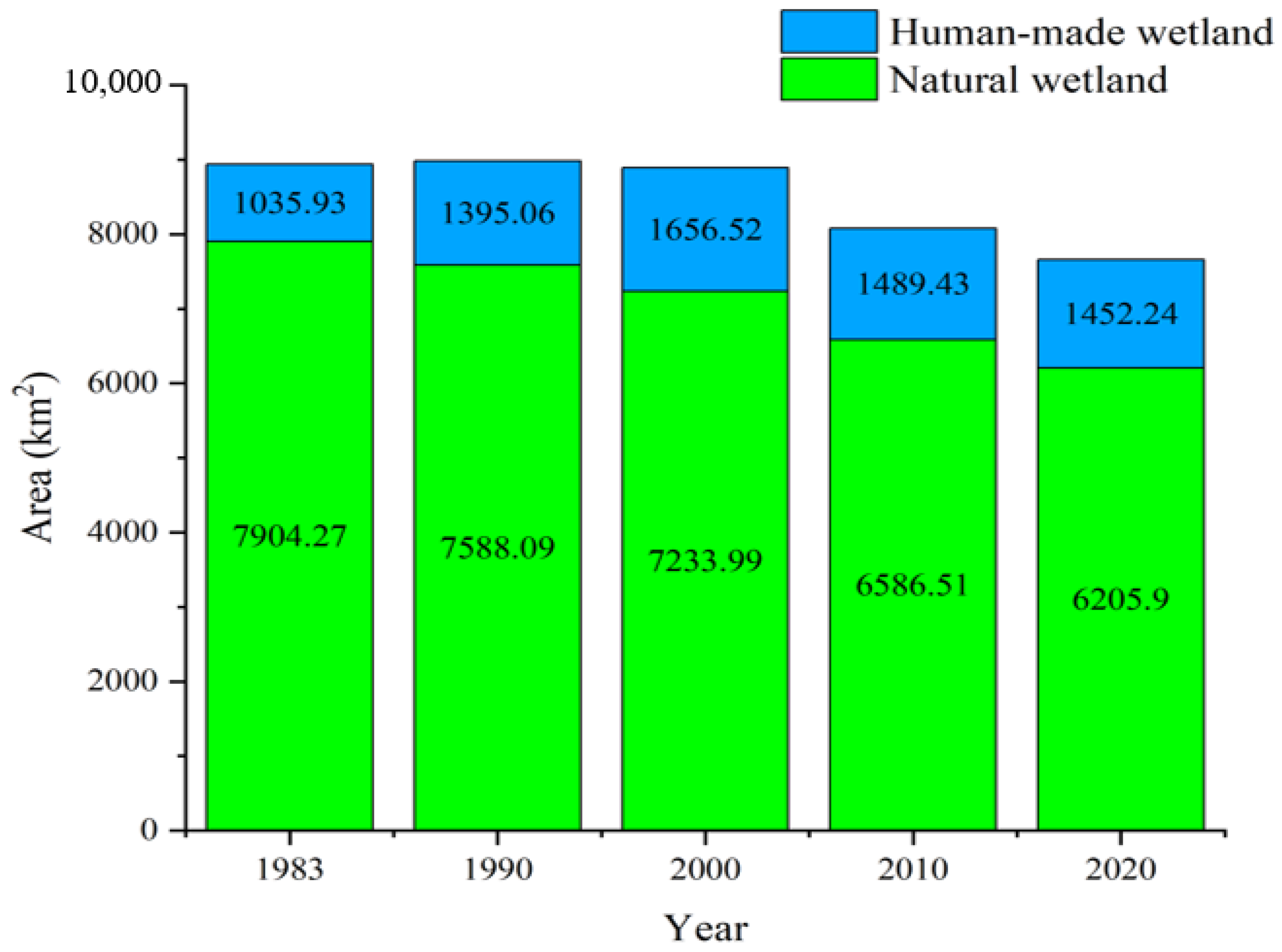
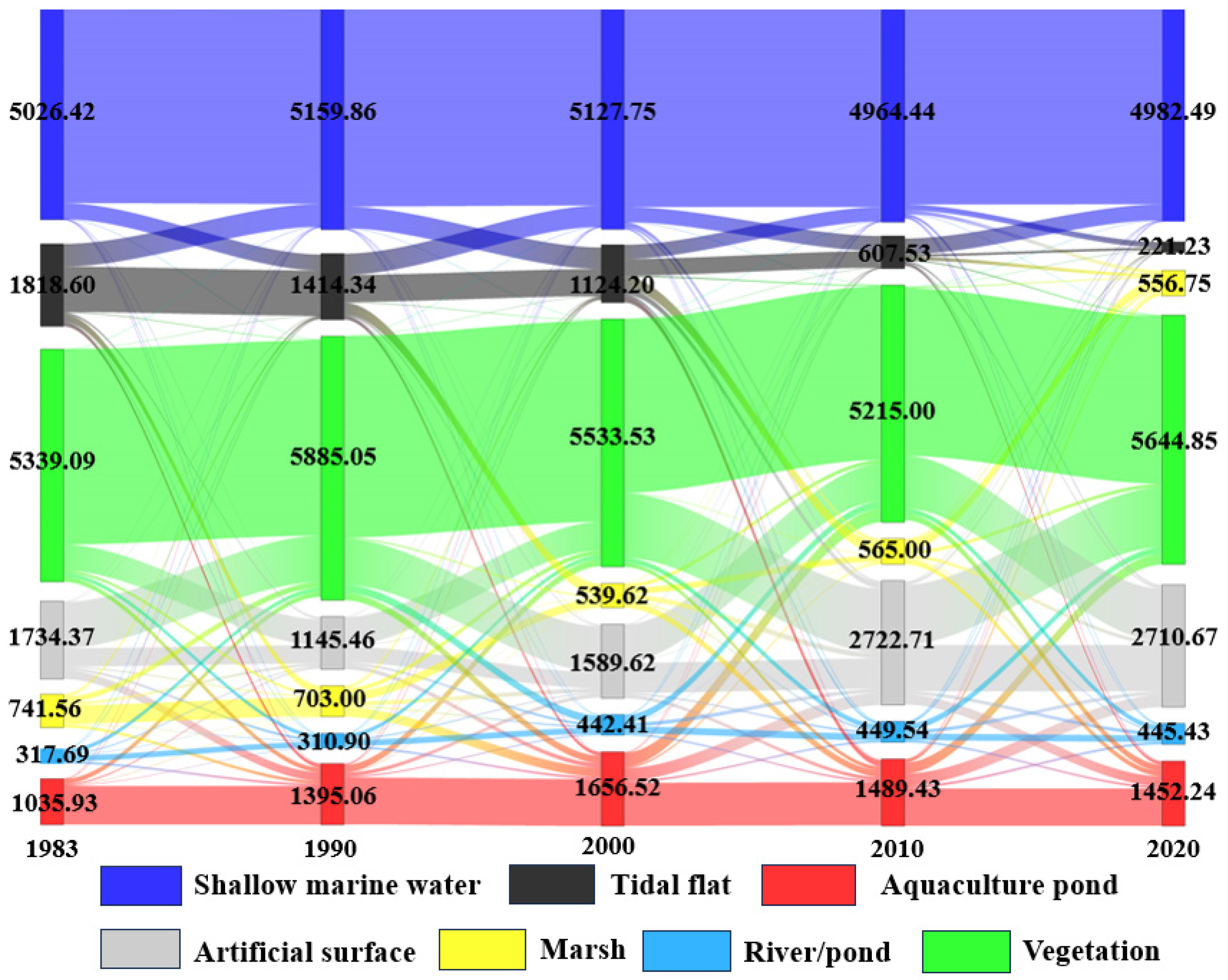
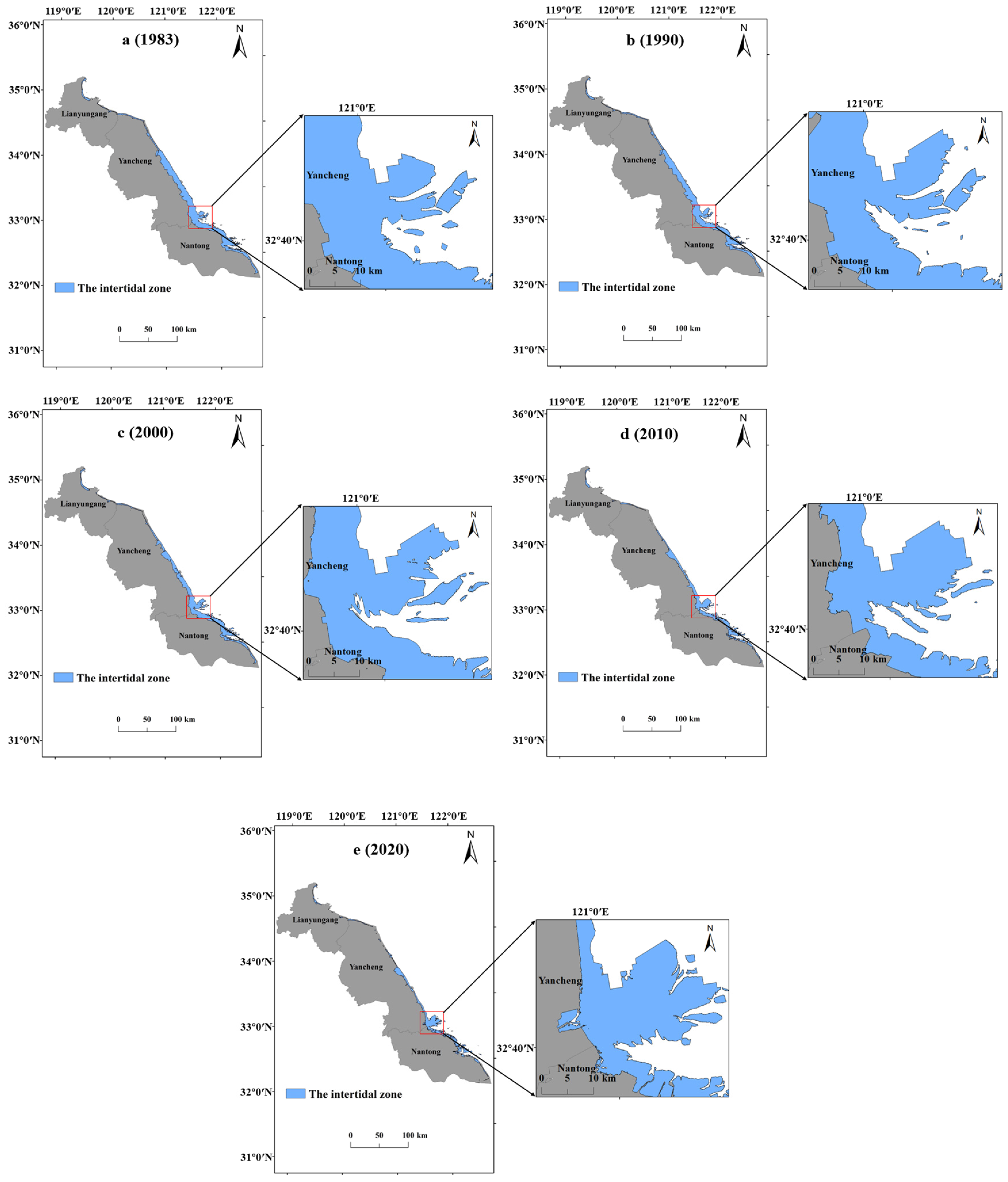
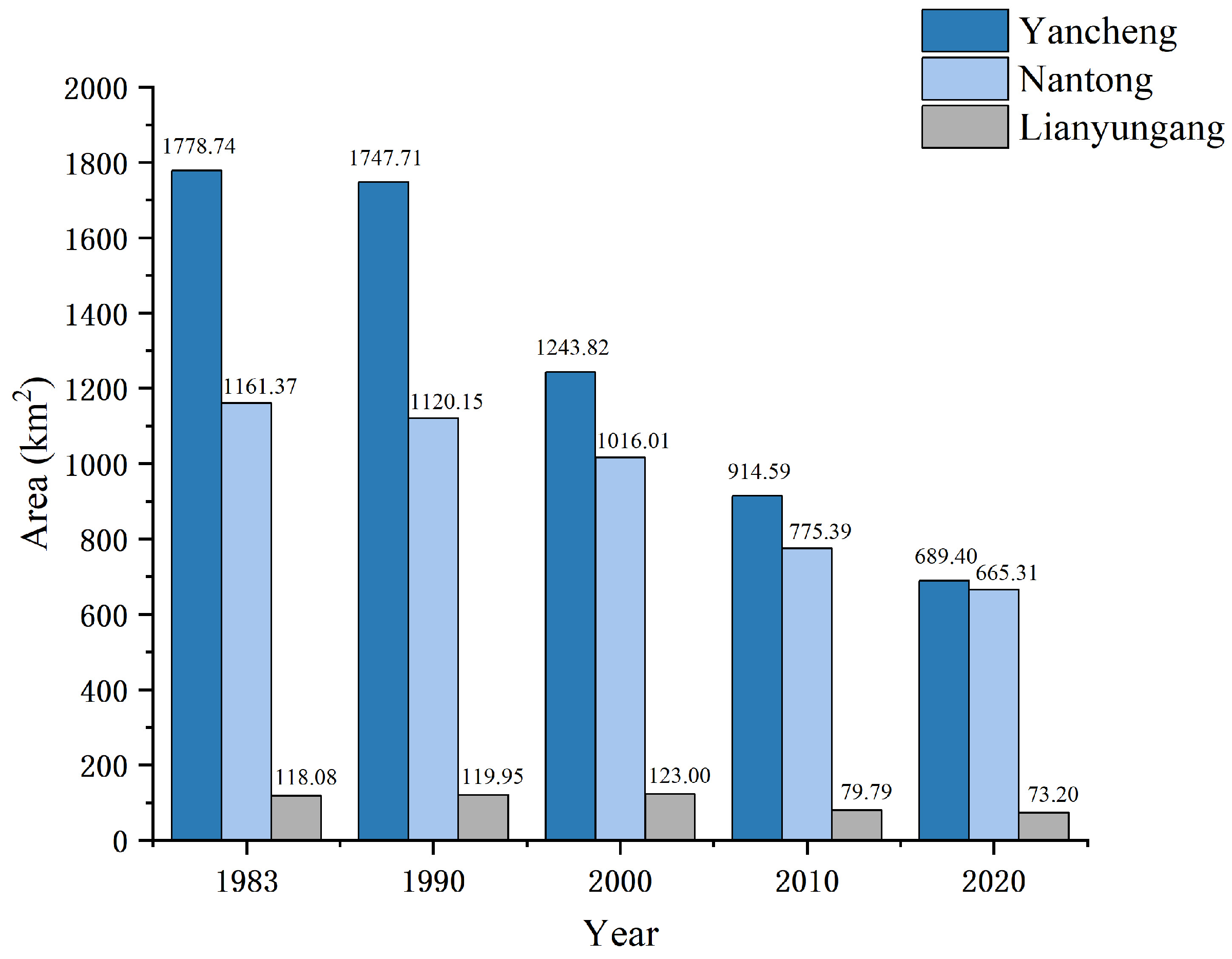
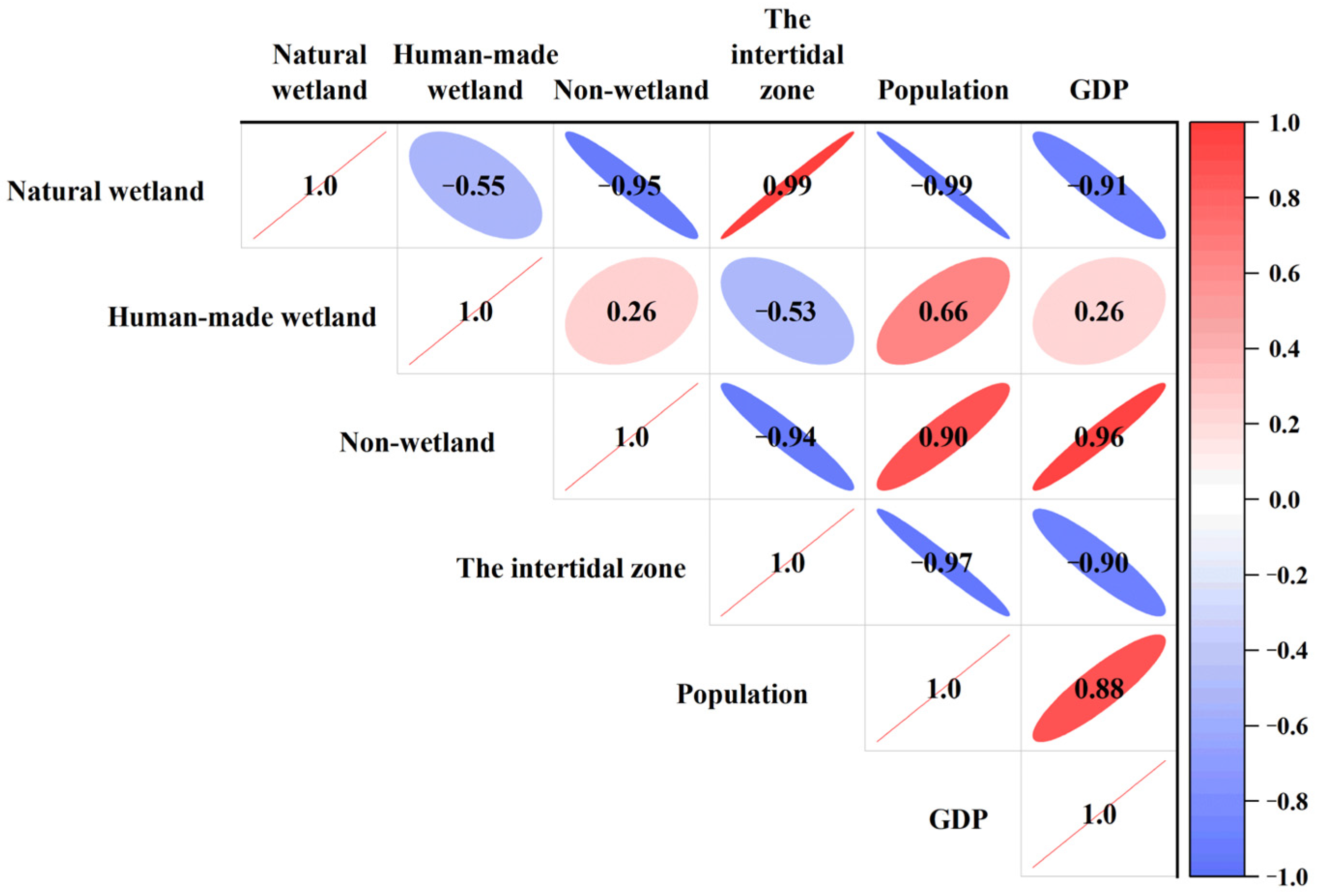
| Category I | Category II | Description |
|---|---|---|
| Natural wetland | Marsh | Natural wetland dominated by herbaceous plants, with the characteristic of periodic flooding. |
| Tidal flat | Sea areas below the high-tide line and above the low-tide line with little or no vegetation cover. | |
| Shallow marine water | The marine body of water between the shoreline and the 6-m deep contour. | |
| River/pond | Natural waters with linear or other geometric shapes. | |
| Human-made wetland | Aquaculture pond | Bodies of water used for aquaculture in coastal areas, usually with a regular shape. |
| Non-wetland | Vegetation | Land covered with trees, grass, crops, etc., excluding marsh vegetation. |
| Artificial surface | Various structures and regions formed by human activities, with specific functions and characteristics, such as roads and buildings, etc. |
| Type | Feature Name | Definition or Description |
|---|---|---|
| Spectral features | NDVI | |
| NDWI | ||
| mNDWI | ||
| Brightness | ||
| Shape features | Length/width | The ratio of the length of an object to its width |
| Shape index | The border length feature of an image object divided by four times the square root of its area | |
| Compactness | Describe whether and to what extent the object is compact | |
| Texture features | GLCM-contrast | Describe local variations in the object |
| GLCM-homogeneity | Describe the degree of similarity of the objects | |
| Topological relations | Neighbor distance | The distance from one class to another |
| Category I | Category II | Sample Number | Producer’s Accuracy | User’s Accuracy |
|---|---|---|---|---|
| Natural wetland | Shallow marine water | 44 | 95.45% | 93.83% |
| River/pond | 31 | 93.55% | 92.27% | |
| Tidal flat | 33 | 90.91% | 88.35% | |
| Marsh | 38 | 92.11% | 91.43% | |
| Human-made wetland | Aquaculture pond | 52 | 92.38% | 91.61% |
| Non-wetland | Vegetation | 186 | 93.01% | 89.97% |
| Artificial surface | 69 | 92.75% | 87.71% | |
| Summary | 453 | Overall accuracy = 92.94% | Kappa = 0.89 |
| 2000 | 2010 | Shrinkage Rate | |
|---|---|---|---|
| IWI | 2382.82 km2 | 1769.77 km2 | 25.73% |
| Publicly available dataset | 2706.76 km2 | 2033.64 km2 | 24.87% |
| Comparison error | 11.97% | 12.98% |
Disclaimer/Publisher’s Note: The statements, opinions and data contained in all publications are solely those of the individual author(s) and contributor(s) and not of MDPI and/or the editor(s). MDPI and/or the editor(s) disclaim responsibility for any injury to people or property resulting from any ideas, methods, instructions or products referred to in the content. |
© 2024 by the authors. Licensee MDPI, Basel, Switzerland. This article is an open access article distributed under the terms and conditions of the Creative Commons Attribution (CC BY) license (https://creativecommons.org/licenses/by/4.0/).
Share and Cite
Huang, Z.; Tang, W.; Zhao, C.; Jiao, C.; Zhu, J. The Spatiotemporal Evolution of the Mudflat Wetland in the Yellow Sea Using Landsat Time Series. Remote Sens. 2024, 16, 4190. https://doi.org/10.3390/rs16224190
Huang Z, Tang W, Zhao C, Jiao C, Zhu J. The Spatiotemporal Evolution of the Mudflat Wetland in the Yellow Sea Using Landsat Time Series. Remote Sensing. 2024; 16(22):4190. https://doi.org/10.3390/rs16224190
Chicago/Turabian StyleHuang, Zicheng, Wei Tang, Chengyi Zhao, Caixia Jiao, and Jianting Zhu. 2024. "The Spatiotemporal Evolution of the Mudflat Wetland in the Yellow Sea Using Landsat Time Series" Remote Sensing 16, no. 22: 4190. https://doi.org/10.3390/rs16224190
APA StyleHuang, Z., Tang, W., Zhao, C., Jiao, C., & Zhu, J. (2024). The Spatiotemporal Evolution of the Mudflat Wetland in the Yellow Sea Using Landsat Time Series. Remote Sensing, 16(22), 4190. https://doi.org/10.3390/rs16224190









